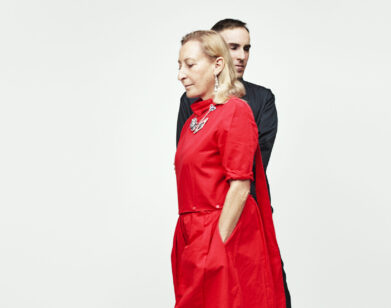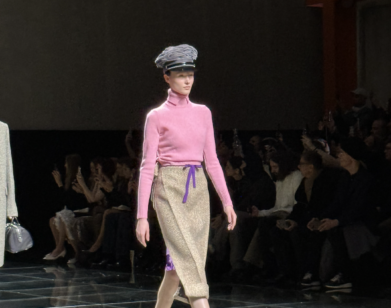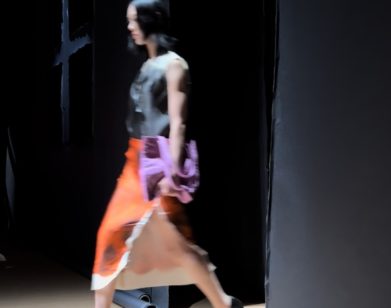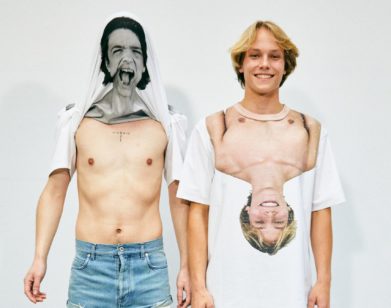Whatever happened to Raf’s diffusion line, Raf by Raf Simons?
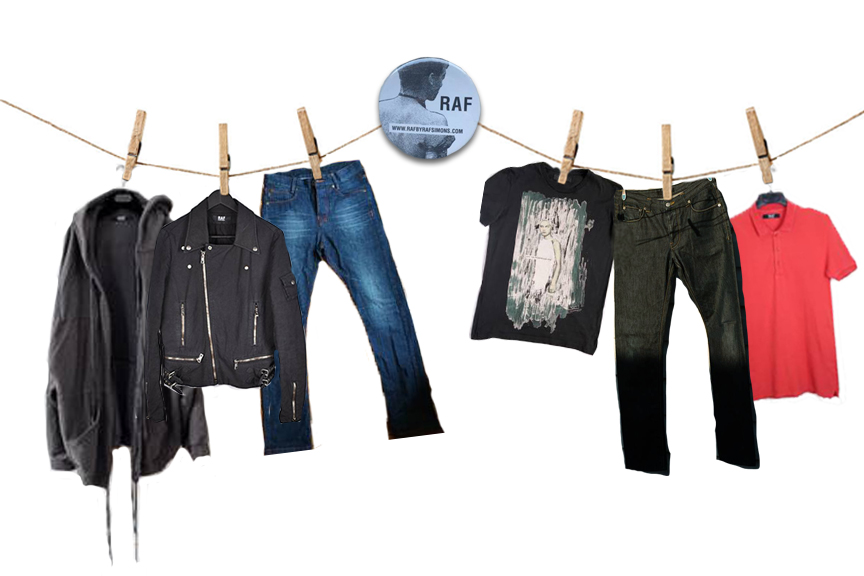
SELECTED PIECES FROM RAF BY RAF SIMONS. GRAPHIC BY CLARISSA DAVIS
For a designer that’s garnered such an obsessive, Supreme-head-like, devoted following, you’d expect Belgian designer Raf Simons’s career to be meticulously documented. You’d expect the timeline of his career to be clear. Foolproof. Indisputably accurate. Yet somehow this isn’t the case; for, in the agreed-upon timeline in Simons’s career exists a conspicuous discrepancy—a curious, gaping hole that goes by the name of Raf by Raf Simons.
Floating around in the fashion stratosphere are multiple theories about the line, what happened to it, and the purpose of Raf Simons 1995, the line that apparently replaced it. The most agreed upon timeline is that Raf by Raf Simons was launched in 2005, and was then replaced by Raf Simons 1995 in 2011; however, according to a High Snobiety article, Raf by Raf Simons “went on hold in 2009.” Marc Sebastian—Kim Jones’s former creative personal assistant at Louis Vuitton and a walking encyclopedia of the industry—told me he didn’t even know there was a difference between Raf by Raf Simons and the main line. Ditto model Jacob Bird, who’s written countless articles for Dazed and i-D and has walked the runway for Raf Simons. It seems the actual life of Raf by Raf Simons—the story of the diffusion line’s conception and closing—is, in fact, rather simple. What’s compelling is the fissure in Simons’s image that his diffusion line has caused, and the reaction this has inspired in his diehard fans.
Founded in 2005, Raf by Raf—or RAF, as some people refer to it—was Simons’s “self-proclaimed ‘second line,’” according to a July 2007 Dazed article about the line. As Simons himself explained, the line was his attempt at recreating the youth-centric aesthetic that defined the former part of his career. One could have even called Raf by Raf Simons his passion project. And upon announcing this new line, as rumors from buyers and some photos were just beginning to circulate, his biggest supporters—young fans who had stood behind him since the beginning—had high hopes. Everyone wanted to get their hands on these allegedly affordable iterations of Simons’s most popular main line pieces. A coveted leather motorcycle jacket that was reinterpreted in wool, for instance, with silver zippers and buckles and a quilted layer. It was named the Wool Perfecto Jacket. Sweatshirts that were printed with Joy Division graphics, which he used in his Fall 2001 main line collection, and a selection of highly tailored garments that recall the meticulous tailoring in his main line—the difference being that these were fabricated in more casual poplin or cotton gabardine.
On The Fashion Spot’s “Community” forum, a young Simons fan with the username “tricotineacetat” wrote in 2005—before the release of Raf by Raf Simons but after the diffusion line was announced—that this new line “will be the more wearable, young wardrobe to build upon,” and that “the mainline will definitely gain from it and become more sophisticated.” Simons’s fans saw this as Simons giving them an opportunity to own a piece of his designs at a much lower price point. Tricotineacetat went on, “I actually much appreciate the fact that certain designers are starting to address a customer that might not be able to pay the full price of their mainline collections … those that can appreciate [Simons’s designs] often cannot afford the full retail price.”
The reality of Raf by Raf Simons, however, turned out to be far different from what these hopeful fans were anticipating, with the line going in a direction that few expected from the designer. When the clothes first arrived in stores in 2006, they were distinctly poor in quality—something his fans quickly picked up on. As Fashion Spot user “Marquischacha” wrote, “The items don’t look very special at all. I would put it a step above American Apparel in quality but then they don’t charge 100+ bucks for a simple tshirt/sweat shirt.” Another called the line “HORRIBLE…pathetic.” T-shirts were just that—nothing notable or “Raf” about them—if not worse: some, according to Fashion Spot user “Baizilla,” were “made of some kind of cotton/elastane fabric that just feels awful when worn … similar to wearing a cycling t-shirt.” Another Fashion Spot user, “new_dawn_fades,” said he heard multiple complaints about the jeans falling apart quickly. As Michael Kardamakis, the owner of ENDYMA—a massive archive of some of the rarest Simons, Helmut Lang, and Burberry pieces—who has a deep knowledge of Simons told me, the quality of Raf by Raf Simons got even worse in 2008 and 2009, when they released “really bad jeans, scarves, and knits. [It was] all over the place. There were collections that were absolutely dreadful.”
Raf by Raf Simons was purported to be a line made explicitly for Simons’s fan base that represented the youth and subcultures he so often took inspiration from—the fans who saw something of themselves in his “outsider” identity. One can imagine, then, the disappointment they must have felt when the line was finally released and the designs were conspicuously basic and unexceptional, falling prey to the shoddiness that defines any old random diffusion line. Everything from the fabric quality to the designing and craftsmanship were lacking, grossly inadequate. Even the prices were a letdown; according to Fashion Spot user “faust,” a pair of Raf by Raf jeans “cost $330,” despite being “exact replicas of the main line jeans he’s done before … that cost $195.”
According to multiple sources, in 2011, Raf by Raf Simons was replaced with Raf Simons 1995, which Kardamakis called, “A better effort at making a Raf diffusion line that was more on point with Raf’s vision … More in line with the Raf aesthetic.” But the damage, it seems, had already been done. And that damage may very well have been enough to propel any Simons enthusiast into a state of denial—which may, in turn, help explain the indeterminate timeline of Raf by Raf Simons and the line that replaced it. The theories and alternative narratives that surround Raf by Raf Simons could very well be a result of Simons’s fans projecting their hopes and desires onto a nadir in Raf’s career. Back on The Fashion Spot forums, another user called “The Baron” showed just how far Raf fans are willing to look into his work in order to convince themselves that he’s the man they want him to be. “Everything [Raf] does has these little references to musical culture past & present,” he said. Looking at the “Raf by Raf Simons” logo that was released in October of 2005, right after Raf by Raf Simons was announced, he goes on, “I’m thinking this time [the name references] a mod thing. RAF as in Royal Air Force … red white and blue … ‘My Generation’ … one of the archetypal instances of a well-dressed youth culture. It’s not just Raf, it’s R.A.F. by Raf Simons.” And yet … is it?
Commenting on the Raf by Raf Simons line, Kardamakis told me, “Only someone who isn’t Raf could pull that thing off and go to sleep at night.” And while it’s true that the line was produced in Italy as a license by Futurepresent (apparently a “joint venture of Futurenet and Mitsui Italia”), Simons also made it explicitly clear in his 2007 Dazed interview that he was the sole designer of this line, saying, “The one thing I will say is, I will never let [Raf by Raf Simons] go into the hands of someone else.”
When I brought up Raf Simons 1995, there seemed to be conflicting notions of this line as well. Kardamakis seemed to corroborate this when he asked me, “Is Raf Simons 1995 not going on anymore?” Even David Casavant, the foremost collector of Raf Simons whose archive was described as “Museum-Level” by GQ, and who’s been collecting Simons pieces (among other designers) since the inception of Raf Simons, seemed highly dubious about the chronology during this particular time in Simons’s career. When I told him that Raf by Raf Simons was apparently replaced by Raf Simons 1995 in 2011, he laughed. “No, this is the thing,” he told me. “Raf’s whole brand [for a] very long time [was] just him and a couple assistants in a studio doing whatever [they wanted to do] and not being too serious about it.” Seeming to reference the sort of fans like “The Baron,” he goes on, “A lot of these kids try to be cool and pretend they know what’s up and read way more into these types of things than actually was meant in any of it. Rumors get created that way and they pretend they’re fact and they’re actually not,” he says, adding, “People think way too much into it.” Simply put, he said, “Raf by Raf [happened] because everyone was doing those types of diffusion lines [at the time], and Raf wasn’t selling his main stuff that well, so they were trying to do more accessible stuff … trying to find a way to make money in the commercial realm.” As I mentioned before, the actual life of Raf by Raf seems rather simple. It’s just grappling with these sorts of truths that Casavant seems unbothered by—truths that create an unexpected fissure in Simons’s worshipped, pristine image—that’s not so simple a task for some of his fans.
Perhaps this sort of cultural amnesia amongst his fans, this collective projection and desire to see only what they wish to see, is not entirely responsible for the murky trajectory of Raf by Raf Simons. But it is a compelling theory for a fashion plot hole that’s seemed to have gone almost entirely overlooked. It’s like fashion’s biggest blind spot. But I’d venture to guess that there’s someone out there with an active Grailed account who knows more—and I invite you to please clear this up … if I haven’t yet made an enemy of you.

